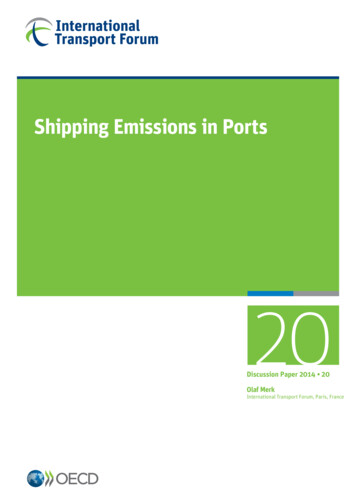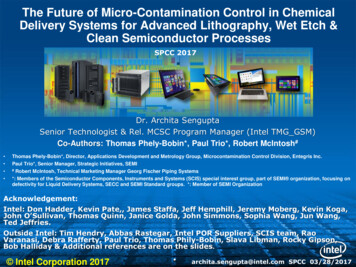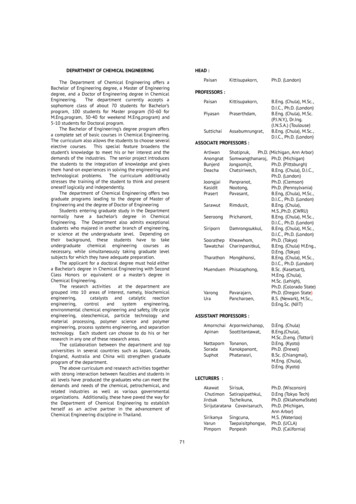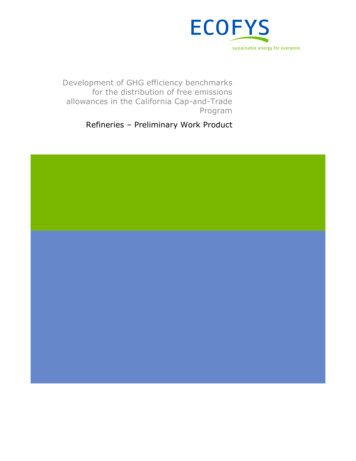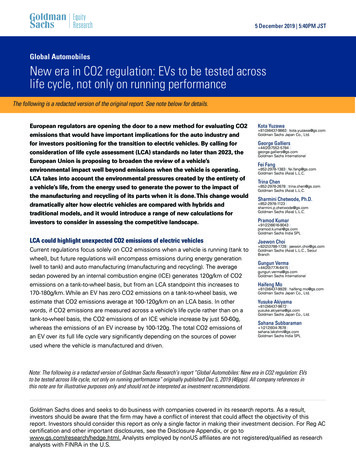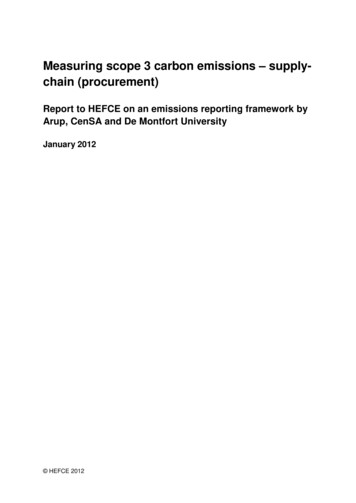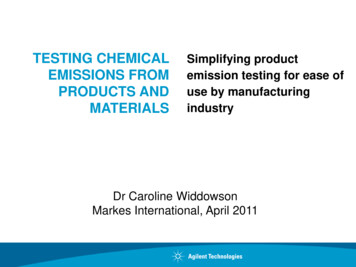
Transcription
TESTING CHEMICALEMISSIONS FROMPRODUCTS ANDMATERIALSSimplifying productemission testing for ease ofuse by manufacturingindustryDr Caroline WiddowsonMarkes International, April 2011
Emission testing by manufacturingindustry is governed by regulationsand market pressure.
Construction product regulations examplesNew regulations for testing chemical emissions from constructionproducts are getting stricter all over the worldNew US buildingcodesConstruction ProductDirective/Regulation(CPD/CPR)Chinese „REACH‟
Construction product regulations andassociated developments in EuropeConstruction Product Regulation adopted in Feb 2011 Implementation by 2013 Requires „3rd party accreditation and FactoryProduction Control (FPC)Process to harmonise target compounds and limitlevels (LCIs)Construction ProductRegulation (CPR) 2011 Prelim list due 2011, final list due 2012Based on ISO 16000 seriesEssential Requirement 3: Hygiene, health and theenvironment – minimise the emissions of dangeroussubstances, volatile organic compounds (VOC),greenhouse gases or dangerous particles into indoor air
The 2005 Germanflooring regulationand AgBB schemeTarget compounds: 160 toxic VOCs 30 carcinogensEmission data are converted tovapour concentrations in areference room. Limit levels arequoted as „lowest concentrationsof interest‟ (LCIs)
2010 French regulation applies toconstruction and decorative products Implementation: all new products by Sept2011 and for all products by Sept 2013. Products are not failed under the Frenchscheme but are labelled A , A, B or C. Theclass is assigned depending on the worstperforming compound of interest. France also operates the voluntary AFSSETscheme which includes nearly 200 targetcompounds and is very similar to AgBBCompounds of nzeneethylbenzenen-butyl acetate From 2012, construction products may onlybe sold in France if they show 28-dayemission levels below 1 μg/m³ fortrichloroethylene, benzene, DEHP and DBPtested with ISO 16000 and calculated forEuropean reference room.2-butoxyethanolstyreneTVOC3 specified carcinogens
Construction product regulations and similardevelopments in the US Vs 1.1 of Ca Spec 01350 fast becominguniversal US protocol for emission testing.– Enshrined in: ANSI/ASHRAE 189.1, IgCC (2nded.), BIFMA M7 revision, etc.– Based on D5116 (chamber) & D6196 (TD-GCMS)– Similar to AgBB/AFSSETPrimary legalinstrument likely to beUS building codes UL acquisition of AQS/GEI signals the growingimportance of product emission testing in the US ASTM stds also available for emission screening:– D7706 Micro-scale chamber– D7143 FLEC NIST collaborating with lead European agenciesto improve analytical QA for mat ems testing:– Check stds, PT schemes, CRMs.
Key MethodsISOISO 16000-3Indoor air – Part 3: Determination of formaldehyde and othercarbonyl compounds – Active sampling methodISOISO 16000-6Indoor air – Part 6: Determination of VOCs in indoor & testchamber air by sampling on Tenax sorbent, TD-GC MS/FIDCEN/ISO EN/ISO 16000-9CEN/ISO EN/ISO 16000-10CEN/ISO EN/ISO 16000-11Indoor Air – Part 9: Emission test chamber method (Small)Indoor Air – Part 10: Emission test cell method (FLEC)Indoor Air – Part 11: Procedure for sampling and storage ofsamples and preparation of test specimensISOISO DIS 1600023/24Performance test for evaluating the reduction offormaldehyde (part 23) or VOC (pt 24) concentrations bysorptive building materialsISOISO DIS 16000-25Determination of the emission of semi-volatile organiccompounds by building products - Micro-chamber methodCalifornia Section 01350Standard Method for testing & evaluation of VOC emissionsfrom indoor sources using environmental chambers
Automotive methods/techniquesDirect desorptionVDA 278MicrochamberSmall chambersISO 12219-3ASTM 7706VDA 276ISO 12219-4
Reference methods for testing chemicalemissions from productsISO 16000-series methods(or Ca01350 based on ASTM stds in the US)1. Place the material in a test chamber or cell.2. Collect the vapours3. Analyse by TD-GC/MS (VOCs) or HPLC(formaldehyde)4. Evaluate data versus target compound lists andlimit levels
Step 1: Place the material in a test chamber or cellA FLEC cellThe sample is incubated at 23ºC under a flow ofclean air at 50% relative humidity* 28 ºC in Japan, 25 ºC in KoreaPhoto: Eurofins Environment A/S
Step 2: Collect the vapoursVapour sampling:3 & 28 days or at10 to 14 days(this is a longtest!)Photo: Eurofins Environment A/S2 sorbent tubes in series 2 tube sets in parallel 4 tubes per measurement blanks
Steps 3 & 4: Sampleand data analysis TD-GC/MS/FID: Markesversatile TD technology isuniquely suitable foremission testing. Volatile,semi-volatile AND reactivespecies can be handled inone run. HPLC: is used forformaldehyde andcarbonyls TD-GC/MS: emissionprofiles can be verycomplex. DRS &TargetView can simplify &enhance data processingPaintCarpet
Certification/labellingIn Europe alone there arecurrently 20 differentlabels, each requiring adifferent but similar testprotocolNew regulations aim toreplace all these differentlabelling schemes with onee.g.‒ CE mark in Europe‒ IgCC or UL in USAAfter CE marking the best voluntary schemes, e.g. theGerman Blue Angel, might survive as optional additionallabels (gold stars!)
Certification/labellingVOC emission testingAccreditedLabFactoryproductcontrol
Complexity of reference methodis not practical to set up withinthe manufacturing industry
FLEC methodsISO 16000-10, D7143 The Field and Laboratory Emission Cell (FLEC) is an easy-to-usedevice for the certification of indoor products/materials according totheir VOC emission levels (EN ISO 16000-10, ASTM D7143).
FLEC methodsISO 16000-10, D7143Typical analytical conditions: Sample area: 177 cm2 Test time: Equilibration 24 hrs (certification), 1–2 hrs (routine) Vapour sampling: 15–30 mins using a Tenax TA or Quartz/Tenax TA/Carbopack X tube TD System: UNITY 2 or TD-100 Trap: U-T9TNX-2S (Tenax) or U-T12ME-2S (Material emissions) Analysis: GC/MS
Secondary emission screening methodsMicro-Chamber/Thermal Extractor (µ-CTE )** UK patent application 0501928.6 Simpler/quicker emissionscreening for in-houseindustrial applications: routineQC, R&D, etc. Surface-only or bulkemissions can be assessed 4 or 6 samples/hour Sorbent tubes or DNPHcartridges
µ-CTE: Tubes are attached to all micro-chambers inparallel. 4 or 6 samples can be processed in 1 hrSample tubeHeated lid: The collar projectingfrom lid defines area for surfaceonly emission testing andminimises ingress of edgeemissionsMicro-chamber data hasbeen shown to correlate withresults from long term testsusing ordinary chambersAir spaceSampleSpacers to presentsample at correct heightProprietary flowcontrol device – nopump requiredHeated airstream
µ-CTE: Tubes are attached to all micro-chambers inparallel. 4 or 6 samples can be processed in 1 hrSample tubeBulk Emissions Ambient/ Elevated temperature Dynamic Headspace1. Set temp. and flow2.Insert sample Building Material Liquid Soil sample etc.3. Collect compounds4. Analyseusing TD GC/MS(ISO 16000-6)Air spaceSample
Standardisation of micro-chamber methodsISO 12219-3 for car trim and 16000-25 for SVOCs in constructionproductsASTM D7706 for construction and other products used indoorsCEN TC351 – as secondary/indirect method and/or for contenttesting for construction productsVDI 2083 for cleanroom construction materials and possiblefollow on ISO stdGUT (and possible follow on ISO standard)ASTM working group for spray polyurethane foamThese are all secondary / screening methods
Correlation: can µ-CTE data be used to predictlonger term reference test results?Small chamber DaysTedlar bagHoursMicrochamberMinutes
Micro-Chamber/ThermalExtractor: Testing chemicalsreleased by children‟s plastic toys1. Toluene2. Ethyl benzene3. p-xylene4. o-xylene5. Cyclohexanon6. 2-butoxy ethanol7. Tricyclodecane8. Diethyl phthalate9. Dibutyl phthalate10. Dioctyl phthalate34152687910Typical analytical conditions: μ-CTE gas flow: 100 mL/min μ-CTE temperature: 40⁰C Test time: 20 mins equilibration,15 mins vapour sampling Sorbent tube: Quartz/TenaxTA/Carbopack X TD system: TD-100 Trap: U-T12ME-2S Materialemissions
What is Thermal Desorption?Sorbent MaterialSample Matrixe.g. Chamber ormicro-chamber air
What is Thermal Desorption?Sample passes onto the sorbentCompounds of interest are adsorbed on thesorbent surface
What is Thermal Desorption?Lighter gases such as nitrogen passthrough the sorbent
What is Thermal Desorption?Sorbent is now heated in a reversed flow ofclean carrier gas (back flushed)
What is Thermal Desorption?Compounds are released from the sorbent intothe flow of carrier gasIt is a simple extension of the technique of Gas Chromatography andis a sample introduction technology for difficult or real-worldsamples
2 Stage Thermal DesorptionPROBLEM: Compounds are released SLOWLY from thesorbent tubeWould lead to very wide chromatographic peaks and lowsensitivity
2 Stage Thermal DesorptionSOLUTION: Use a narrow secondary trapSTAGE 1Transfer compounds fromtube to secondary trapElectrically coolednarrow bore cold trap
2 Stage Thermal DesorptionSTAGE 2Rapid transfer ofcompounds from coldtrap to GCCold trap heated rapidly (100 C/sec) for sharpchromatographic peaksBackflush of cold trap for greater volatility range
Cold TrapFlow during trapdesorptionRestricted narrowbore inlet / outletend of trapFlow during focusing /sampling onto trapNarrow design allows splitless injectionUse sorbent(s) to suit specific application15 standard traps custom packed traps available from Markes
What can TD-GC/MS do?Any volatile or semi-volatile organic compounds which meet thefollowing criteria: n-C40, bpt 525 C Can be easily gas chromatographed The sorbent or matrix containing the compounds is compatible withthe high temperatures requiredUnsuitable compounds Inorganic compounds Most permanent gases – exceptions include N2O, SF6 & CS2 Compounds with volatility n-C40 Compounds which don‟t work well with GC (including formaldehyde) Methane
Emissions testing equipment - SummaryManualAutomated
Validating TD-GC/MS analytical performance formaterial emission testingProposed compound list:Check standard* for monitoringsystem performance; peak shape,peak ratios, carryover, etc.Proposed compounds cover relevantanalyte volatility and polarity rangeCan be applied e.g.: At system installationAs a routine in-house checkFor troubleshootingBy accredited 3rd party auditorsn-hexanetoluenemethyl isobutyl ketonebutyl 1,2,34-phenylcyclohexenebutylated hydroxytoluene* Check std developed by Markes in conjunctionwith international expertsn-hexadecane
clohexanoneButyl acetateHexanalTolueneMethyl isobutyl ketoneN-hexaneMaterial emission check standard
Certified reference material Polymer film is loaded with a representative volatile organic compound(currently focusing on toluene) through a diffusion process. What makes this prototype reference material “unique” is that its emissionrate can be measured in a traditional chamber test, as well asindependently verified using material/chemical properties and afundamental mass transfer model.Photo: Eurofins Environment A/S
Applications in accredited test labsNew regulations require product emissions testsby accredited third party labs.Billable services will include:1. Certification of products using referencemethods2. Auditing the quality control measures usedby industry3. Emissions screening service for smallcompanies e.g. for QC or R&DIncreased in-house testing by manufacturers will generateadditional auditing revenue for accredited test houses
Product emission testing is an businessopportunity for manufacturersAs well as aiding regulatory compliance, in-house product emission testinghelps manufacturers to: Test the quality of raw materials Compare emissions profiles across a range (red vs. blue finish) Pre-screen products before expensive 3rd party emission tests Compare products with competitive materials Develop new, low-emission, higher-value materials in R&D and Differentiate low emission products from cheap competitors
www.markes.comcwiddowson@markes.com
ISO 12219-3 for car trim and 16000-25 for SVOCs in construction products ASTM D7706 for construction and other products used indoors CEN TC351 -as secondary/indirect method and/or for content testing for construction products VDI 2083 for cleanroom construction materials and possible follow on ISO std GUT (and possible follow on ISO standard)

